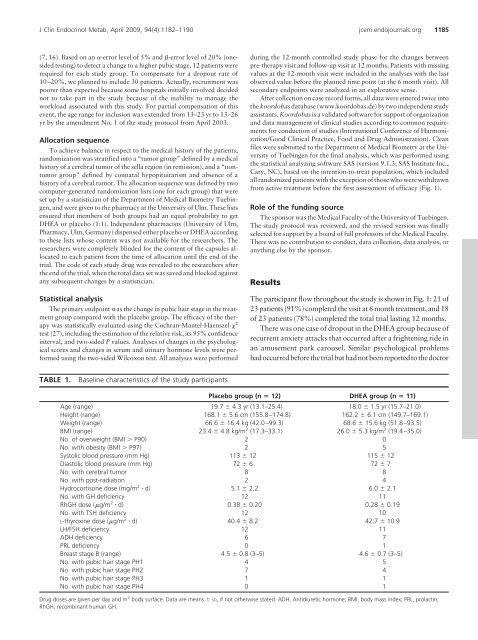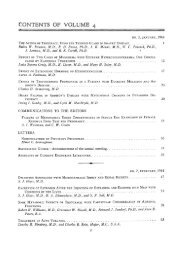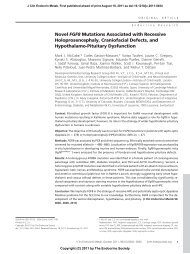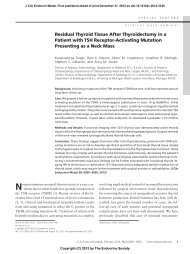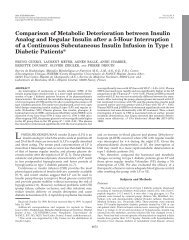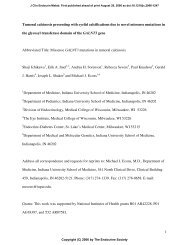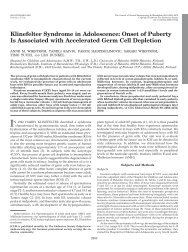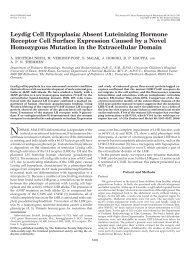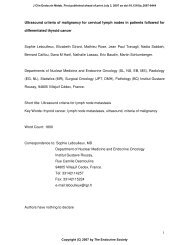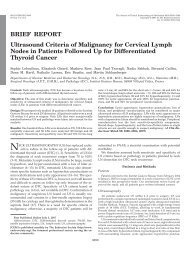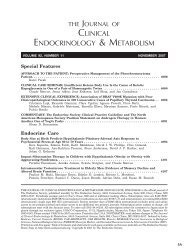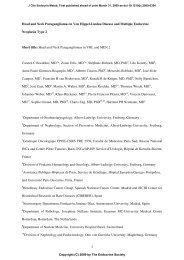Effects of Dehydroepiandrosterone Therapy on Pubic Hair Growth ...
Effects of Dehydroepiandrosterone Therapy on Pubic Hair Growth ...
Effects of Dehydroepiandrosterone Therapy on Pubic Hair Growth ...
You also want an ePaper? Increase the reach of your titles
YUMPU automatically turns print PDFs into web optimized ePapers that Google loves.
J Clin Endocrinol Metab, April 2009, 94(4):1182–1190 jcem.endojournals.org 1185<br />
(7, 16). Based <strong>on</strong> an -error level <str<strong>on</strong>g>of</str<strong>on</strong>g> 5% and -error level <str<strong>on</strong>g>of</str<strong>on</strong>g> 20% (<strong>on</strong>esided<br />
testing) to detect a change to a higher pubic stage, 12 patients were<br />
required for each study group. To compensate for a dropout rate <str<strong>on</strong>g>of</str<strong>on</strong>g><br />
10–20%, we planned to include 30 patients. Actually, recruitment was<br />
poorer than expected because some hospitals initially involved decided<br />
not to take part in the study because <str<strong>on</strong>g>of</str<strong>on</strong>g> the inability to manage the<br />
workload associated with this study. For partial compensati<strong>on</strong> <str<strong>on</strong>g>of</str<strong>on</strong>g> this<br />
event, the age range for inclusi<strong>on</strong> was extended from 13–23 yr to 13–26<br />
yr by the amendment No. 1 <str<strong>on</strong>g>of</str<strong>on</strong>g> the study protocol from April 2003.<br />
Allocati<strong>on</strong> sequence<br />
To achieve balance in respect to the medical history <str<strong>on</strong>g>of</str<strong>on</strong>g> the patients,<br />
randomizati<strong>on</strong> was stratified into a “tumor group” defined by a medical<br />
history <str<strong>on</strong>g>of</str<strong>on</strong>g> a cerebral tumor <str<strong>on</strong>g>of</str<strong>on</strong>g> the sella regi<strong>on</strong> (in remissi<strong>on</strong>), and a “n<strong>on</strong>tumor<br />
group” defined by c<strong>on</strong>natal hypopituitarism and absence <str<strong>on</strong>g>of</str<strong>on</strong>g> a<br />
history <str<strong>on</strong>g>of</str<strong>on</strong>g> a cerebral tumor. The allocati<strong>on</strong> sequence was defined by two<br />
computer-generated randomizati<strong>on</strong> lists (<strong>on</strong>e for each group) that were<br />
set up by a statistician <str<strong>on</strong>g>of</str<strong>on</strong>g> the Department <str<strong>on</strong>g>of</str<strong>on</strong>g> Medical Biometry Tuebingen,<br />
and were given to the pharmacy at the University <str<strong>on</strong>g>of</str<strong>on</strong>g> Ulm. These lists<br />
ensured that members <str<strong>on</strong>g>of</str<strong>on</strong>g> both groups had an equal probability to get<br />
DHEA or placebo (1:1). Independent pharmacists (University <str<strong>on</strong>g>of</str<strong>on</strong>g> Ulm,<br />
Pharmacy, Ulm, Germany) dispensed either placebo or DHEA according<br />
to these lists whose c<strong>on</strong>tent was not available for the researchers. The<br />
researchers were completely blinded for the c<strong>on</strong>tent <str<strong>on</strong>g>of</str<strong>on</strong>g> the capsules allocated<br />
to each patient from the time <str<strong>on</strong>g>of</str<strong>on</strong>g> allocati<strong>on</strong> until the end <str<strong>on</strong>g>of</str<strong>on</strong>g> the<br />
trial. The code <str<strong>on</strong>g>of</str<strong>on</strong>g> each study drug was revealed to the researchers after<br />
the end <str<strong>on</strong>g>of</str<strong>on</strong>g> the trial, when the total data set was saved and blocked against<br />
any subsequent changes by a statistician.<br />
Statistical analysis<br />
The primary endpoint was the change in pubic hair stage in the treatment<br />
group compared with the placebo group. The efficacy <str<strong>on</strong>g>of</str<strong>on</strong>g> the therapy<br />
was statistically evaluated using the Cochran-Mantel-Haenszel- 2<br />
test (27), including the estimati<strong>on</strong> <str<strong>on</strong>g>of</str<strong>on</strong>g> the relative risk, its 95% c<strong>on</strong>fidence<br />
interval, and two-sided P values. Analyses <str<strong>on</strong>g>of</str<strong>on</strong>g> changes in the psychological<br />
scores and changes in serum and urinary horm<strong>on</strong>e levels were performed<br />
using the two-sided Wilcox<strong>on</strong> test. All analyses were performed<br />
TABLE 1. Baseline characteristics <str<strong>on</strong>g>of</str<strong>on</strong>g> the study participants<br />
during the 12-m<strong>on</strong>th c<strong>on</strong>trolled study phase for the changes between<br />
pre-therapy visit and follow-up visit at 12 m<strong>on</strong>ths. Patients with missing<br />
values at the 12-m<strong>on</strong>th visit were included in the analyses with the last<br />
observed value before the planned time point (at the 6 m<strong>on</strong>th visit). All<br />
sec<strong>on</strong>dary endpoints were analyzed in an explorative sense.<br />
After collecti<strong>on</strong> <strong>on</strong> case record forms, all data were entered twice into<br />
the koordobas database (www.koordobas.de) by two independent study<br />
assistants. Koordobas is a validated s<str<strong>on</strong>g>of</str<strong>on</strong>g>tware for support <str<strong>on</strong>g>of</str<strong>on</strong>g> organizati<strong>on</strong><br />
and data management <str<strong>on</strong>g>of</str<strong>on</strong>g> clinical studies according to comm<strong>on</strong> requirements<br />
for c<strong>on</strong>ducti<strong>on</strong> <str<strong>on</strong>g>of</str<strong>on</strong>g> studies (Internati<strong>on</strong>al C<strong>on</strong>ference <str<strong>on</strong>g>of</str<strong>on</strong>g> Harm<strong>on</strong>izati<strong>on</strong>/Good<br />
Clinical Practice, Food and Drug Administrati<strong>on</strong>). Clean<br />
files were submitted to the Department <str<strong>on</strong>g>of</str<strong>on</strong>g> Medical Biometry at the University<br />
<str<strong>on</strong>g>of</str<strong>on</strong>g> Tuebingen for the final analysis, which was performed using<br />
the statistical analyzing s<str<strong>on</strong>g>of</str<strong>on</strong>g>tware SAS (versi<strong>on</strong> 9.1.3; SAS Institute Inc.,<br />
Cary, NC), based <strong>on</strong> the intenti<strong>on</strong>-to-treat populati<strong>on</strong>, which included<br />
all randomized patients with the excepti<strong>on</strong> <str<strong>on</strong>g>of</str<strong>on</strong>g> those who were withdrawn<br />
from active treatment before the first assessment <str<strong>on</strong>g>of</str<strong>on</strong>g> efficacy (Fig. 1).<br />
Role <str<strong>on</strong>g>of</str<strong>on</strong>g> the funding source<br />
The sp<strong>on</strong>sor was the Medical Faculty <str<strong>on</strong>g>of</str<strong>on</strong>g> the University <str<strong>on</strong>g>of</str<strong>on</strong>g> Tuebingen.<br />
The study protocol was reviewed, and the revised versi<strong>on</strong> was finally<br />
selected for support by a board <str<strong>on</strong>g>of</str<strong>on</strong>g> full pr<str<strong>on</strong>g>of</str<strong>on</strong>g>essors <str<strong>on</strong>g>of</str<strong>on</strong>g> the Medical Faculty.<br />
There was no c<strong>on</strong>tributi<strong>on</strong> to c<strong>on</strong>duct, data collecti<strong>on</strong>, data analysis, or<br />
anything else by the sp<strong>on</strong>sor.<br />
Results<br />
The participant flow throughout the study is shown in Fig. 1: 21 <str<strong>on</strong>g>of</str<strong>on</strong>g><br />
23 patients (91%) completed the visit at 6 m<strong>on</strong>th treatment, and 18<br />
<str<strong>on</strong>g>of</str<strong>on</strong>g> 23 patients (78%) completed the total trial lasting 12 m<strong>on</strong>ths.<br />
There was <strong>on</strong>e case <str<strong>on</strong>g>of</str<strong>on</strong>g> dropout in the DHEA group because <str<strong>on</strong>g>of</str<strong>on</strong>g><br />
recurrent anxiety attacks that occurred after a frightening ride in<br />
an amusement park carousel. Similar psychological problems<br />
had occurred before the trial but had not been reported to the doctor<br />
Placebo group (n 12) DHEA group (n 11)<br />
Age (range) 19.7 4.3 yr (13.1–25.4) 18.0 1.5 yr (15.7–21.0)<br />
Height (range) 168.1 5.6 cm (155.8–174.8) 162.2 6.1 cm (149.7–169.1)<br />
Weight (range) 66.6 16.4 kg (42.0–99.3) 68.6 15.6 kg (51.8–93.5)<br />
BMI (range) 23.4 4.8 kg/m 2 (17.3–33.1) 26.0 5.3 kg/m 2 (19.4–35.0)<br />
No. <str<strong>on</strong>g>of</str<strong>on</strong>g> overweight (BMI P90) 2 0<br />
No. with obesity (BMI P97) 2 5<br />
Systolic blood pressure (mm Hg) 113 12 115 12<br />
Diastolic blood pressure (mm Hg) 72 6 72 7<br />
No. with cerebral tumor 8 8<br />
No. with post-radiati<strong>on</strong> 2 4<br />
Hydrocortis<strong>on</strong>e dose (mg/m 2 d) 5.1 2.2 6.0 2.1<br />
No. with GH deficiency 12 11<br />
RhGH dose (g/m 2 d) 0.38 0.20 0.28 0.19<br />
No. with TSH deficiency 12 10<br />
L-thyroxine dose (g/m 2 d) 40.4 8.2 42.7 10.9<br />
LH/FSH deficiency 12 11<br />
ADH deficiency 6 7<br />
PRL deficiency 0 1<br />
Breast stage B (range) 4.5 0.8 (3–5) 4.6 0.7 (3–5)<br />
No. with pubic hair stage PH1 4 5<br />
No. with pubic hair stage PH2 7 4<br />
No. with pubic hair stage PH3 1 1<br />
No. with pubic hair stage PH4 0 1<br />
Drug doses are given per day and m 2 body surface. Data are means SD, if not otherwise stated. ADH, Antidiuretic horm<strong>on</strong>e; BMI, body mass index; PRL, prolactin;<br />
RhGH, recombinant human GH.


